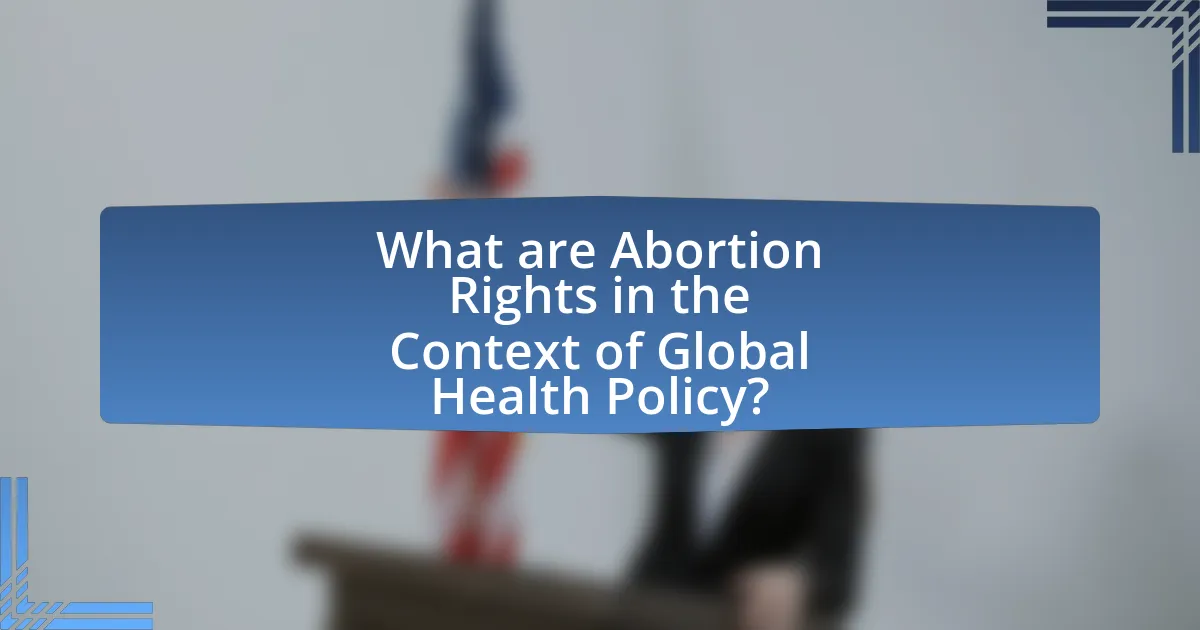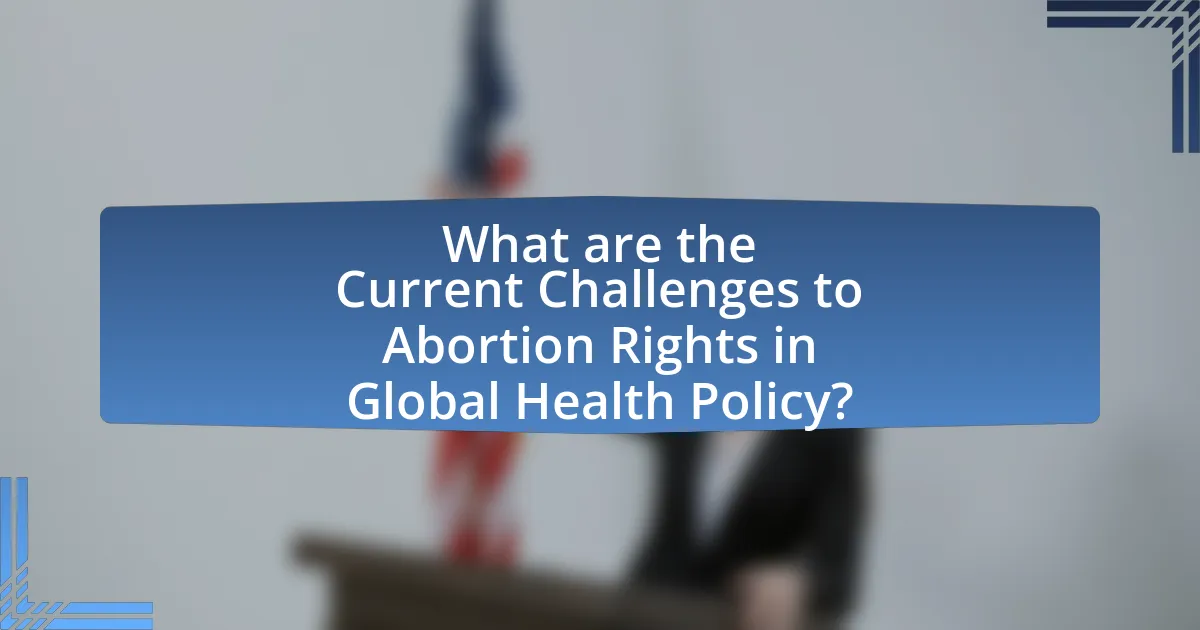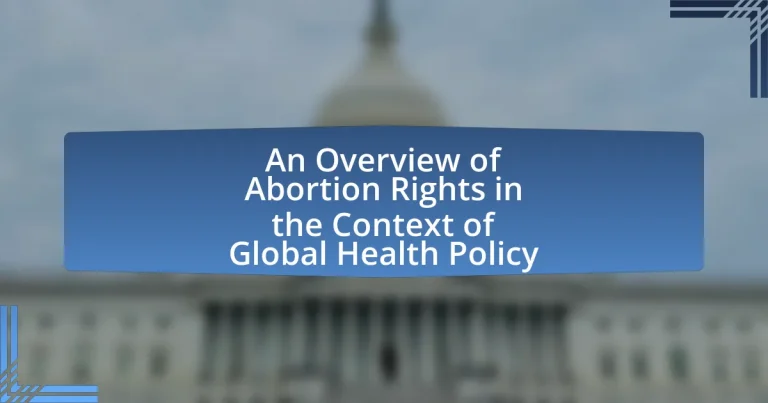Abortion rights are defined as the legal and ethical entitlements of individuals to access safe and legal abortion services within the framework of global health policy. This article provides an overview of the significance of abortion rights, highlighting their impact on women’s health, autonomy, and socio-economic status. It examines the variation of abortion rights across different countries, the legal frameworks that govern them, and the influence of cultural attitudes. Additionally, the article discusses the historical developments, current challenges, and future directions for abortion rights in global health policy, emphasizing the role of advocacy, education, and equitable access to services in promoting reproductive health.

What are Abortion Rights in the Context of Global Health Policy?
Abortion rights in the context of global health policy refer to the legal and ethical entitlements of individuals to access safe and legal abortion services as part of comprehensive reproductive health care. These rights are recognized by various international health organizations, including the World Health Organization, which emphasizes that access to safe abortion is essential for protecting women’s health and rights. Evidence shows that restrictive abortion laws do not reduce the number of abortions but rather lead to unsafe procedures, contributing to maternal morbidity and mortality. For instance, the Guttmacher Institute reports that unsafe abortions account for approximately 13% of maternal deaths globally, highlighting the critical need for policies that ensure safe access to abortion services.
How do abortion rights vary across different countries?
Abortion rights vary significantly across different countries, influenced by cultural, legal, and political factors. For instance, in countries like Canada and the Netherlands, abortion is legal and accessible, often without restrictive conditions, reflecting a progressive stance on reproductive rights. Conversely, nations such as El Salvador and Nicaragua impose strict bans on abortion, even in cases of rape or health risks, highlighting a conservative approach to reproductive health. According to the World Health Organization, approximately 25 million unsafe abortions occur annually, predominantly in regions with restrictive laws, underscoring the impact of legal frameworks on women’s health outcomes.
What legal frameworks govern abortion rights globally?
Legal frameworks governing abortion rights globally vary significantly by country and region, reflecting diverse cultural, religious, and political contexts. In many countries, laws range from complete prohibition to full legalization, with some nations allowing abortion under specific circumstances such as health risks or fetal anomalies. For instance, countries like Canada and the Netherlands have legalized abortion with few restrictions, while nations such as El Salvador and Nicaragua impose total bans, even in cases of rape or health risks to the mother. The World Health Organization emphasizes that access to safe and legal abortion is a critical component of reproductive health rights, underscoring the need for legal frameworks that protect women’s health and autonomy.
How do cultural attitudes influence abortion rights in various regions?
Cultural attitudes significantly influence abortion rights across various regions by shaping public opinion, legislative frameworks, and access to services. In regions where conservative cultural beliefs prevail, such as in many parts of Latin America and Africa, restrictive laws often limit abortion access, reflecting societal views that prioritize traditional family structures and religious doctrines. Conversely, in more liberal regions like Western Europe and parts of North America, progressive cultural attitudes support reproductive rights, leading to more permissive laws and greater access to abortion services. For instance, countries like Sweden and Canada have implemented policies that uphold women’s autonomy over reproductive choices, demonstrating how cultural acceptance can translate into legal protections for abortion rights.
Why are abortion rights considered a critical aspect of global health policy?
Abortion rights are considered a critical aspect of global health policy because they directly impact women’s health, autonomy, and socio-economic status. Access to safe and legal abortion services reduces maternal mortality rates; for instance, the World Health Organization estimates that unsafe abortions contribute to 13% of maternal deaths globally. Furthermore, ensuring abortion rights promotes gender equality and empowers women to make informed choices about their reproductive health, which is essential for achieving broader health and development goals.
What impact do abortion rights have on women’s health outcomes?
Abortion rights significantly improve women’s health outcomes by ensuring access to safe and legal abortion services. Research indicates that when abortion is legal and accessible, women are less likely to resort to unsafe procedures, which can lead to severe health complications or death. For instance, the World Health Organization reports that unsafe abortions account for approximately 13% of maternal deaths globally, highlighting the critical role of legal abortion in reducing these risks. Furthermore, studies show that countries with more liberal abortion laws tend to have lower rates of maternal morbidity and mortality, reinforcing the positive correlation between abortion rights and women’s health.
How do restrictions on abortion rights affect public health systems?
Restrictions on abortion rights negatively impact public health systems by increasing maternal morbidity and mortality rates. When access to safe and legal abortion services is limited, individuals may resort to unsafe procedures, leading to complications that strain healthcare resources. For instance, the World Health Organization reports that unsafe abortions contribute to approximately 47,000 deaths annually, highlighting the direct correlation between restrictive policies and adverse health outcomes. Furthermore, public health systems face increased costs due to the need for treating complications arising from unsafe abortions, diverting resources from other essential health services.
What are the historical developments of abortion rights in global health policy?
The historical developments of abortion rights in global health policy have evolved significantly since the mid-20th century. In 1968, the World Health Organization (WHO) recognized unsafe abortion as a major public health issue, leading to increased advocacy for safe and legal abortion access. The 1994 International Conference on Population and Development in Cairo marked a pivotal moment, where over 179 countries acknowledged reproductive rights, including access to safe abortion, as essential to women’s health. In 2000, the WHO published guidelines emphasizing the need for safe abortion services, further solidifying the role of abortion rights in global health policy. By 2018, the WHO updated its recommendations, highlighting the importance of integrating abortion care into comprehensive health services, reflecting a growing recognition of women’s autonomy and health needs in global health frameworks.
How have international treaties and agreements shaped abortion rights?
International treaties and agreements have significantly influenced abortion rights by establishing frameworks that promote reproductive health and gender equality. For instance, the Convention on the Elimination of All Forms of Discrimination Against Women (CEDAW), adopted in 1979, obligates signatory states to eliminate discrimination against women, which includes ensuring access to safe and legal abortion services. Additionally, the International Conference on Population and Development (ICPD) in 1994 emphasized the importance of reproductive rights, advocating for women’s autonomy in making decisions about their bodies, including abortion. These agreements have led to legal reforms in various countries, enhancing women’s access to abortion services and shaping national policies to align with international human rights standards.
What role do non-governmental organizations play in advocating for abortion rights?
Non-governmental organizations (NGOs) play a crucial role in advocating for abortion rights by mobilizing resources, raising awareness, and influencing policy. These organizations often provide education on reproductive health, legal support, and access to safe abortion services, particularly in regions where such rights are restricted. For instance, organizations like Planned Parenthood and the Center for Reproductive Rights actively engage in legal battles and public campaigns to protect and expand abortion access, demonstrating their impact through successful litigation and policy changes in various countries. Additionally, NGOs often collaborate with local communities to ensure that marginalized voices are heard in the discourse surrounding reproductive rights, thereby reinforcing their advocacy efforts with grassroots support.

What are the Current Challenges to Abortion Rights in Global Health Policy?
Current challenges to abortion rights in global health policy include restrictive legislation, cultural stigma, and limited access to healthcare services. Many countries have enacted laws that severely limit or outright ban abortion, impacting women’s health and autonomy. For instance, in the United States, the overturning of Roe v. Wade in 2022 led to numerous states implementing strict abortion bans, which has resulted in increased maternal mortality rates and health complications. Additionally, cultural stigma surrounding abortion persists in many regions, discouraging women from seeking necessary medical care. The World Health Organization reports that unsafe abortions contribute significantly to maternal deaths, highlighting the urgent need for policy reform to ensure safe and legal access to abortion services globally.
How do political climates affect abortion rights worldwide?
Political climates significantly influence abortion rights worldwide by shaping legislation, public opinion, and access to services. In countries with conservative political environments, such as Poland and El Salvador, restrictive laws often limit or completely ban abortion, reflecting the influence of religious and traditional values. Conversely, nations with progressive political climates, like Canada and the Netherlands, tend to support reproductive rights, resulting in more accessible abortion services and legal protections. For instance, in the United States, the political shift following the 2020 elections led to varying state-level laws, with some states enacting stricter regulations while others expanded access, demonstrating how political leadership directly impacts abortion rights.
What are the consequences of anti-abortion legislation on women’s health?
Anti-abortion legislation negatively impacts women’s health by restricting access to safe and legal abortion services, leading to increased rates of unsafe abortions and associated health complications. Studies indicate that in regions with stringent anti-abortion laws, women are more likely to resort to unsafe methods, resulting in higher maternal mortality rates. For instance, the World Health Organization reports that unsafe abortions contribute to approximately 47,000 deaths annually worldwide, primarily in countries with restrictive abortion laws. Furthermore, such legislation can exacerbate mental health issues, as women may experience increased anxiety, depression, and trauma related to unwanted pregnancies and lack of reproductive autonomy.
How do economic factors influence access to abortion services?
Economic factors significantly influence access to abortion services by determining the affordability and availability of these services. For instance, in regions where healthcare funding is limited, women may face higher out-of-pocket costs for abortion procedures, leading to decreased access. A study by the Guttmacher Institute found that in the United States, states with more restrictive abortion laws often have fewer clinics, which correlates with lower income levels among women seeking these services. Additionally, economic disparities can affect transportation options, making it difficult for women in low-income areas to reach facilities that provide abortions. Thus, economic conditions directly impact both the financial and logistical aspects of accessing abortion services.
What are the barriers to safe abortion access in low-income countries?
Barriers to safe abortion access in low-income countries include restrictive legal frameworks, lack of healthcare infrastructure, and social stigma. Restrictive laws often criminalize abortion, limiting access to safe procedures and forcing women to seek unsafe alternatives. For instance, according to the World Health Organization, approximately 25 million unsafe abortions occur annually, predominantly in regions with stringent abortion laws. Additionally, inadequate healthcare facilities and trained personnel hinder the provision of safe abortion services, as many clinics lack the necessary resources. Social stigma surrounding abortion further discourages women from seeking help, leading to increased health risks and negative outcomes.
How does stigma surrounding abortion impact women’s choices?
Stigma surrounding abortion significantly impacts women’s choices by creating barriers to accessing safe and legal abortion services. This stigma often leads to feelings of shame and fear, which can deter women from seeking necessary medical care or support. Research indicates that in countries with high levels of stigma, women may resort to unsafe abortion methods, increasing health risks; for instance, the World Health Organization reports that unsafe abortions contribute to approximately 13% of maternal deaths globally. Additionally, stigma can influence women’s decision-making processes, leading them to delay or forgo abortion even when it is legally available, as evidenced by studies showing that women often prioritize societal perceptions over their own health needs.
What role does misinformation play in shaping public opinion on abortion rights?
Misinformation significantly influences public opinion on abortion rights by perpetuating false narratives and misconceptions. For instance, studies have shown that misleading information about the health risks of abortion can lead to increased stigma and opposition to abortion rights, as seen in various surveys where individuals exposed to misinformation were more likely to hold negative views on the subject. Additionally, misinformation campaigns often exploit emotional appeals, which can sway public sentiment and policy discussions, as evidenced by the rise in restrictive abortion laws in regions where such misinformation is prevalent.

What are the Future Directions for Abortion Rights in Global Health Policy?
Future directions for abortion rights in global health policy include increased advocacy for reproductive health access, integration of abortion services into primary healthcare, and the promotion of evidence-based policies that prioritize women’s health and autonomy. As countries face varying legal frameworks and cultural attitudes, global health organizations are likely to focus on harmonizing standards and practices to ensure safe and legal access to abortion. For instance, the World Health Organization emphasizes the importance of safe abortion as a critical component of comprehensive reproductive health services, highlighting that unsafe abortions contribute significantly to maternal morbidity and mortality. This evidence supports the need for policy reforms that protect and expand abortion rights globally.
How can global health policies be improved to support abortion rights?
Global health policies can be improved to support abortion rights by ensuring access to safe and legal abortion services as part of comprehensive reproductive health care. This can be achieved through the integration of abortion services into national health systems, which has been shown to reduce maternal mortality rates; for instance, the World Health Organization reports that unsafe abortions contribute to approximately 13% of maternal deaths globally. Additionally, policies should be informed by evidence-based guidelines that prioritize women’s health and autonomy, as seen in countries like Canada, where abortion is treated as a health care service rather than a criminal issue. Furthermore, international agreements, such as the Convention on the Elimination of All Forms of Discrimination Against Women, can be leveraged to advocate for the protection and promotion of abortion rights, ensuring that they are recognized as a fundamental aspect of women’s health and human rights.
What best practices can be adopted from countries with progressive abortion laws?
Countries with progressive abortion laws often implement best practices such as comprehensive sex education, accessible healthcare services, and supportive legal frameworks. Comprehensive sex education, as seen in countries like the Netherlands, reduces unintended pregnancies and promotes informed decision-making. Accessible healthcare services, exemplified by Sweden, ensure that abortion is safe, legal, and available without unnecessary barriers, leading to lower maternal mortality rates. Supportive legal frameworks, as practiced in Canada, protect individuals’ rights to choose and provide clear guidelines for healthcare providers, fostering a safe environment for abortion services. These practices contribute to better health outcomes and empower individuals in their reproductive choices.
How can advocacy efforts be strengthened to promote abortion rights?
Advocacy efforts can be strengthened to promote abortion rights by enhancing coalition-building among diverse stakeholders, including healthcare providers, women’s rights organizations, and legal experts. This collaborative approach can amplify voices and create a unified front that effectively addresses legal, social, and health-related barriers to abortion access. Research indicates that countries with strong advocacy coalitions, such as those seen in the United States and Canada, have successfully influenced policy changes and public opinion, leading to improved access to reproductive health services. Additionally, utilizing data-driven campaigns that highlight the health impacts of restricted abortion access can further mobilize public support and influence policymakers.
What role does education play in advancing abortion rights?
Education plays a crucial role in advancing abortion rights by informing individuals about reproductive health, legal rights, and available services. Comprehensive education empowers people to make informed decisions regarding their reproductive choices, thereby fostering advocacy for policy changes that support abortion rights. Studies indicate that regions with higher levels of education tend to have more progressive attitudes towards reproductive rights, as educated individuals are more likely to understand the implications of restrictive abortion laws and advocate for their repeal. For instance, research published in the “American Journal of Public Health” shows that increased education correlates with greater support for abortion access, highlighting the importance of educational initiatives in shaping public opinion and influencing legislative outcomes.
How can awareness campaigns change perceptions about abortion?
Awareness campaigns can change perceptions about abortion by providing accurate information and fostering open dialogue. These campaigns often highlight the complexities surrounding abortion, including health implications, legal rights, and personal stories, which can challenge existing stigmas and misconceptions. For instance, research from the Guttmacher Institute indicates that comprehensive sex education and access to reproductive health information can lead to more informed attitudes towards abortion, reducing stigma and increasing support for reproductive rights. By engaging communities through targeted messaging and education, awareness campaigns can effectively shift public opinion and promote understanding of abortion as a critical aspect of women’s health and rights.
What strategies can be implemented to ensure equitable access to abortion services?
To ensure equitable access to abortion services, strategies must include the implementation of comprehensive healthcare policies that prioritize reproductive rights, the establishment of funding mechanisms to support low-income individuals, and the removal of legal barriers that restrict access. Comprehensive healthcare policies can be evidenced by countries like Canada, where abortion is publicly funded and accessible, leading to higher rates of service utilization among marginalized populations. Funding mechanisms, such as the establishment of grants or subsidies for clinics serving low-income areas, can help alleviate financial burdens. Additionally, removing legal barriers, as seen in countries that have decriminalized abortion, can significantly improve access and reduce stigma, thereby promoting health equity.
What practical steps can individuals take to support abortion rights globally?
Individuals can support abortion rights globally by advocating for policy changes, donating to organizations that promote reproductive rights, and educating themselves and others about the importance of access to safe abortion services. Advocacy efforts can include contacting lawmakers to express support for pro-choice legislation, participating in campaigns that aim to protect and expand abortion rights, and attending rallies or events that raise awareness about reproductive health issues. Donations to organizations such as Planned Parenthood or the Center for Reproductive Rights directly fund initiatives that protect and advance abortion access. Education plays a crucial role; by sharing accurate information about reproductive rights and the consequences of restricted access, individuals can help combat misinformation and stigma surrounding abortion. These actions collectively contribute to a global movement for reproductive justice and the protection of women’s health rights.


